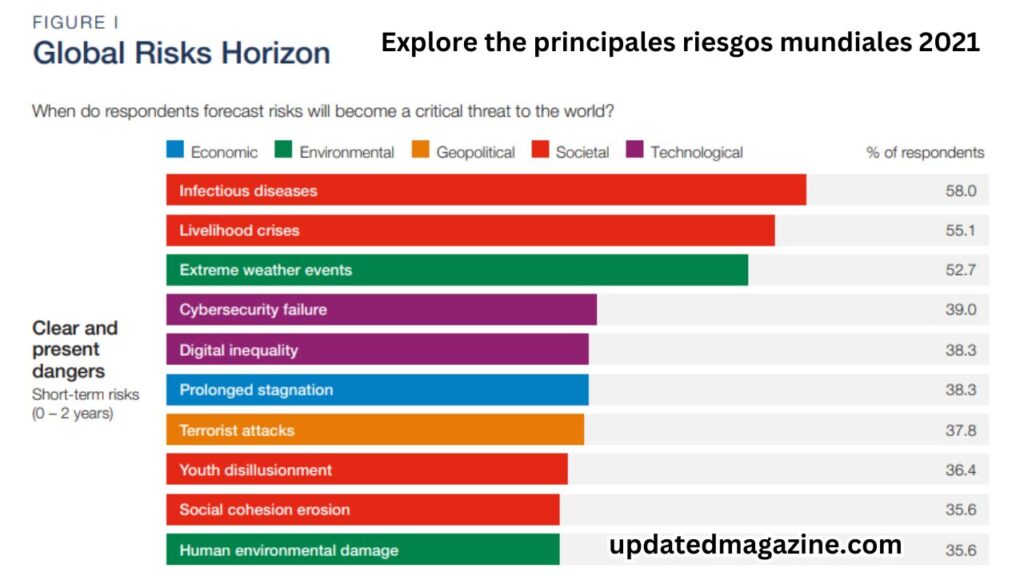In 2021, the world faced a multitude of significant risks that impacted global stability, economies, health systems, and geopolitical dynamics. Understanding these risks is crucial for preparing and mitigating future challenges. https://finanzasdomesticas.com/principales-riesgos-mundiales-2021/.
Introduction
The year 2021 was marked by unprecedented challenges on a global scale. From the ongoing COVID-19 pandemic to geopolitical tensions and climate change, the principal global risks required comprehensive analysis and strategic responses. This article delves into the principal riesgos mundiales 2021, offering insights into their causes, impacts, and potential mitigation strategies. https://finanzasdomesticas.com/principales-riesgos-mundiales-2021/.
Global Risks 2021: An Overview
COVID-19 Pandemic
The COVID-19 pandemic was the predominant global risk in 2021, continuing to affect every facet of life. The rapid spread of the virus strained healthcare systems worldwide and caused significant disruptions to daily life and the global economy. Vaccination campaigns offered hope, but the uneven distribution of vaccines led to prolonged outbreaks in many regions.
Vaccine Distribution and Inequity
A major challenge in addressing the COVID-19 pandemic was the inequitable distribution of vaccines. Wealthier nations secured large quantities of vaccines, while many developing countries struggled to obtain sufficient doses. This disparity not only prolonged the pandemic but also highlighted the need for a more equitable global health strategy.
Economic Recession
The economic impact of the pandemic was profound. Many countries faced recessions, with significant job losses, business closures, and increased national debt. Governments implemented various stimulus measures to support economies, but recovery was uneven across different sectors and regions.
Supply Chain Disruptions
Global supply chains experienced significant disruptions due to the pandemic. Lockdowns and restrictions affected manufacturing and transportation, leading to shortages of goods and rising prices. The fragility of global supply chains became apparent, prompting discussions on the need for more resilient systems.
Climate Change
Climate change remained a critical global risk in 2021, with increasing temperatures and extreme weather events posing severe threats to ecosystems and human societies. Despite international efforts to reduce greenhouse gas emissions, progress was slow, and the impacts of climate change continued to intensify.
Natural Disasters
The year saw numerous natural disasters, including hurricanes, wildfires, floods, and droughts. These events caused widespread damage, loss of life, and displacement of populations, further stressing the importance of climate resilience and disaster preparedness.
Environmental Degradation
Human activities continued to degrade the environment, contributing to biodiversity loss, deforestation, and pollution. These issues compounded the effects of climate change and posed significant risks to the health and livelihoods of people around the world.
Cybersecurity Threats
Cybersecurity emerged as a critical risk in 2021, with cyber attacks becoming more sophisticated and frequent. These threats targeted governments, businesses, and individuals, leading to significant financial losses and compromising sensitive information. https://finanzasdomesticas.com/principales-riesgos-mundiales-2021/.
Cyber Attacks
High-profile cyber attacks, such as ransomware incidents, underscored the vulnerability of digital infrastructure. The attack on Colonial Pipeline in the United States disrupted fuel supplies, highlighting the potential for cyber threats to impact critical services and national security.
Data Privacy Concerns
With the increasing reliance on digital technologies, data privacy became a significant concern. High-profile data breaches and the misuse of personal information raised questions about the adequacy of existing regulations and the need for stronger protections.
Geopolitical Tensions
Geopolitical tensions remained high, with various regions experiencing conflicts and diplomatic standoffs. These tensions affected global stability and had economic and security implications for many countries.
U.S.-China Relations
The relationship between the United States and China was particularly contentious, with disputes over trade, technology, and human rights. These tensions had broad implications for global trade and international relations.
Middle East Conflicts
Conflicts in the Middle East, including ongoing wars in Syria and Yemen, continued to cause humanitarian crises and political instability. Efforts to resolve these conflicts were complicated by regional rivalries and external interventions.
Political Instability
Several countries experienced political instability in 2021, with protests, coups, and contested elections. Political unrest often led to violence and disrupted governance, affecting the lives of millions.
Social Unrest
Social unrest was another major risk, with protests erupting over issues such as racial inequality, economic injustice, and government corruption. These movements highlighted deep-seated societal grievances and demanded systemic change.
Misinformation and Fake News
The spread of misinformation and fake news was a significant challenge, exacerbating social divisions and undermining trust in institutions. Efforts to combat false information were crucial in maintaining informed and cohesive societies.
Technological Advancements
Technological advancements offered both opportunities and risks in 2021. Innovations in areas such as artificial intelligence (AI) and automation had the potential to transform industries but also raised concerns about job displacement and ethical considerations.
AI and Automation
The adoption of AI and automation technologies accelerated, impacting various sectors. While these technologies promised increased efficiency, they also posed challenges related to employment and the ethical use of AI.
Digital Divide
The digital divide remained a critical issue, with unequal access to technology and the internet exacerbating social and economic inequalities. Bridging this gap was essential for ensuring equitable opportunities and development.
Public Health Crises
Beyond COVID-19, other public health crises continued to pose risks. Emerging infectious diseases, antibiotic resistance, and non-communicable diseases required sustained attention and resources.
Mental Health Challenges
The pandemic’s impact on mental health was significant, with increased rates of anxiety, depression, and other mental health issues. Addressing these challenges required comprehensive mental health services and support systems.
Global Inequality
Global inequality persisted, with disparities in wealth, health, and opportunities. Efforts to reduce inequality were essential for fostering sustainable development and social cohesion.
Wealth Disparity
Wealth disparity widened in 2021, with the richest individuals and corporations accumulating more wealth while many struggled with economic hardship. Addressing this disparity was crucial for achieving social justice and economic stability.
Access to Education
The pandemic disrupted education worldwide, exacerbating existing inequalities in access to quality education. Ensuring educational opportunities for all was vital for future generations’ development and prosperity.
Food Security
Food security was a pressing issue, with millions facing hunger and malnutrition. Climate change, conflict, and economic instability were major factors affecting food production and distribution.
Conclusion
The principales riesgos mundiales 2021 highlighted the interconnectedness of global challenges and the need for comprehensive and collaborative solutions. Addressing these risks requires coordinated efforts from governments, businesses, and civil society to build resilience, promote equity, and ensure sustainable development for future generations. https://finanzasdomesticas.com/principales-riesgos-mundiales-2021/.
Also Read: Well Health Tips In Hindi wellhealthorganic
FAQs
What were the principales riesgos mundiales 2021?
The principales riesgos mundiales 2021 included the COVID-19 pandemic, vaccine distribution inequity, economic recession, supply chain disruptions, climate change, natural disasters, cybersecurity threats, geopolitical tensions, social unrest, misinformation, technological advancements, public health crises, global inequality, and food security issues.
How did the COVID-19 pandemic affect global stability in 2021?
The COVID-19 pandemic caused widespread disruption to healthcare systems, economies, and daily life, leading to significant challenges in maintaining global stability. The uneven distribution of vaccines further prolonged the pandemic’s impact.
What were the major cybersecurity threats in 2021?
Major cybersecurity threats in 2021 included sophisticated cyber attacks, such as ransomware incidents, and concerns over data privacy due to high-profile data breaches and the misuse of personal information.
How did climate change contribute to global risks in 2021?
Climate change intensified global risks by causing extreme weather events, contributing to natural disasters, and exacerbating environmental degradation. These impacts posed severe threats to ecosystems and human societies.
What role did geopolitical tensions play in the principales riesgos mundiales 2021?
Geopolitical tensions, such as those between the U.S. and China and conflicts in the Middle East, affected global stability, international relations, and economic conditions, contributing to the principales riesgos mundiales 2021.
Why was the digital divide a significant issue in 2021?
The digital divide was significant because unequal access to technology and the internet exacerbated social and economic inequalities, limiting opportunities for education, employment, and development for disadvantaged populations.












